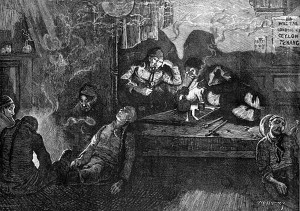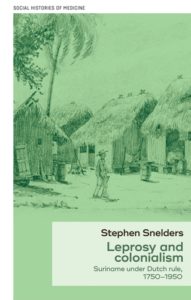THE ORIENTAL FRAMING OF DRUG ABUSE AND THE FEAR OF ‘GOING NATIVE’:
DRUG ADDICTS AND LEPROSY SUFFERERS IN THE AGE OF IMPERIALISM – A COMPARATIVE PERSPECTIVE
PAPER CONFERENCE ‘UNDER CONTROL – ALCOHOL AND DRUG REGULATION, PAST AND PRESENT’, LONDON 21-23 JUNE 2013
Stephen Snelders
1.
It is now the final paper and I guess everybody is longing for a well-deserved drink. I will therefore not delve into another detailed case study. On the contrary, after hearing all the interesting papers presented in our Addiction in Asia panels (and thanks to Jim Mills for organizing and stimulating these panels), I want to ask some questions about the relationship between addiction in Asia and the dynamics of drug control on a wider scale: I am interested here in the relationship between addiction in Asia and addiction in the Empires.

Much has been made by authors as Marianne Valverde and also by myself in the past of the relationship between the (negative) image of the drug addict and the rise of the nation-state in the 19th century. The drug abuser, who relinquishes control over his own will, is the exact antithesis of the responsible democratic citizen that is supposed to be the cornerstone of the democratic project. This analysis makes sense as far as it goes, but here I will suggest that we can also see something different and perhaps more fundamental if we take an imperial perspective. In this paper I will argue that it is not so much the rise of the liberal state that problematizes the use of drugs, but the fears that went together with the extension of imperial dominion over other races.
I will try to argue that our present-day framing of drug use cannot be understood without taking into account the imperialist and global context of 19th-century society. In fact, as I will argue, the process of the framing of drug abuse can be traced back to developments in 18th-century colonial society.
I will try to show this by making a comparison with another process of framing that took place at the onset of imperialism: that of the leprosy sufferer. You might be surprised to hear me make this connection, but is not a new one. In the 1960s, when a large drug-using culture expanded and prohibition became a contested issue, vocal proponents of this drug culture formulated the notion of drug users as victims of society, criminalized and stigmatized. Drug users were, in the sociological theory of Howard Becker, made into outsiders. Users compared themselves to the persecuted medieval witches and lepers. In his Histoire de la folie (Madness and Civilization, 1961). Foucault suggested that the stigma of lepers survived long after leprosy itself had become extinct in Europe and the leprosy asylums had emptied. ‘The values and images connected to the leprosy sufferer continued to exist.’ The games of exclusion were played again, but now with the insane. This analysis has been much discussed and debated. It is not my concern here to enter this discussion. I am not interested here in an exercise in Foucauldian discourse. I am interested however, in a much clearer connection: between the values and images around drug users on the one hand, and leprosy sufferers on the other, in the 19th century.
2.
There is a fascinating similarity in the cultural production of the images of the drug user and of the leprosy sufferer in the 19th century. In both cases, public and medical understanding of a problem mingles and confuses health and social issues, resulting in what I will call an oriental framing, a framing that is intimately bound up with the rise and development of imperialism. A comparison between the oriental framing of drug abuse and that of leprosy is enlightening in this respect. In making this comparison I will draw together the published literature on the histories of drugs and of leprosy.
To start with, we immediately perceive a similarity when reading this quote of leprosy historian Zachary Gussow. He made the important observation that a disease (or a disorder) in itself is perceived as socially threatening. when: ‘The condition must threaten a class of citizens, a way of life; it must arouse public concern; above all, it must give rise to action. It must become a social problem.’
The development of drug use as a social problem has been described and analyzed in the past. To memorize, David Courtwright has described the following development of the public image of drug users in the United States: in the second half of the 19th century the image of the user is still a far cry from our modern perception of the socially degraded junkie. The ‘dominant addict type’ in this period is a woman of middle age from the middle or higher classes. She is dependent on morphine or opium that she takes on the prescription of the family doctor. She looks rather like the typical housewife on barbiturates as depicted in the Rolling Stones’ Mother’s Little Helper.
According to Courtwright after around 1895 this image drastically changes. Drug use becomes more and more associated with non-medical use: at first smoked opium is seen as the most important drug of abuse. At the time of the First World War this has shifted to morphine, and by the 1930s to heroine. On the eve of the Second World War the ‘dominant addict type’ has changed into the ‘nonmedical addict’: the junkie who gets his drug in all possible ways. Next to opium cocaine, sniffed and not injected as in medical use, becomes the number two ‘diabolized’ drug. From 1900 onwards the image of the cocaine fiend develops, an image with strong racist overtones: the cocaine fiend in the South is often a black American sexually threatening white women. Needless to say, the development of the public image of the junkie goes hand in hand with increasing drug legislation. In the United States drug use becomes associated with deviant groups at the borders of society, groups with an often as inferior perceived biological make-up: Afro-Americans, Latin Americans, and so on.
3.
So far so good. But the cultural production of an Orientalized image of the drug abuser starts much earlier, in fact well before drug abuse came to be seen as a significant social problem, and well before the age of imperialism. Let’s get back to Thomas de Quincey and his Confessions of an English Opium Eater (1821) – maybe the earliest and certainly the most well-known example of the oriental framing. As Alethea Hayer wrote about De Quincey, whose Confessions of an opium-eater were first published in1821: he did not break any law, public opinion was not against him or even focused on him, and supplies of his drug were cheap and easily available. It was De Quincey himself who produced a cultural image of his drug use as a threat from oriental regions. In his 1991 study of De Quincey John Barrell claims that De Quincey was ‘terrorised by the fear of an unending and interlinked chains of infections from the east, which threatened to enter his system and to overthrow it, leaving him visibly and permanently ‘compromised’ and orientalised. The Orient here is actually an undifferentiated mixture of Chinese, Indian, Egyptian and other images, forming in the words of Barrell one ‘pathological identity’. ‘The Orient [for De Quincey] is the place of a malign, a luxuriant or virulent productivity, a breeding ground of images of the non-human, or of the no less terrifyingly half-human, which cannot be exterminated, except at the cost of exterminating one’s self, and which cannot be kept back beyond the various Maginot lines […] that De Quincey attempts to defend against the ‘horrid enemy’ from Asia.’ To quote De Quincey himself: ‘I was kissed, with cancerous kisses, by crocodiles; and laid, confounded with all unutterable slimy things, amongst reeds and Nilotic mud.’
As Alan Bewell points out in his Romanticism and Colonial Disease, this threat receives a powerful expression in De Quincey’s account of the Malay that one day knocks on his door. Not only is the Malay a fellow opium-eater and in this respect despite his cultural otherness similar to De Quincey himself, he is also a sexual threat to the white race, personified in his encounter with a beautiful young English girl who had never before seen anything Asian.
However, unlike the orientalized image suggest De Quincey himself was actually far from passive because of his opium use. On the contrary, he describes how, high on opium, he roams the streets of London on Saturday night, relishing the spectacles of the working classes enjoying their time-off. Only later in his life does he appear to succumb to the inactivity and torpor of the opium-eater. De Quincey himself was never an outcast of society.
His orlental framing of his drug use, with the associations of loss of self-control and of identity, confounded in a slimy pit, actually points as much to the past as to the future. It goes back to much earlier medical and social fears that prop up in the European colonial empires. The European who goes native loses the very core-essence of his whiteness and becomes a non-European itself. This is perceived as a a danger for European rule over other races in itself.

4.
As Bewell shows and as every student of early modern colonialism and colonial medicine immediately recognizes, the drug problem of De Quincey is not a national English, but an imperial problem. The changing disease-environment and the close proximity to slaves of African descent prompted inquiries in health and disease of the non-white population in the Caribbean as early as the 18th century. By the later eighteenth century the topic of what feminist historian Londa Schiebinger has called the ‘anatomy of difference’ between races was widely debated among the scientists and savants of Europe. Explanations for these ‘differences’ ranged between environmentalism and hereditarianism, including combinations of both. While in Europe this was of more theoretical concern, in the colonies the question of why and to what extent different races were prey to different diseases was of eminently practical concern. As Sean Quinian writes in his study of the French colonies, the ultimate distinction between the races was located in the amount of self-control a male European could exert, in order to regulate his functioning in accordance with the environment. ‘In a sense, the diseased body became the ultimate signifier of not just the pathological milieu but the total lack of physical self-control exercised by the European individual’, writes Quinian.
It is this racial stereotyping that in the 19th century gets transferred to the yellow and brown races of the Orient. De Quincey points the way. By 1870, the association between drugs, passivity, dirtiness, and race, is exemplified by Dickens in his unfinished The Mystery of Edward Drood. Interestingly enough, this is before the Age of Imperialism really gets into full swing. That drug use could be a habit of an active man, such as Alexandre Dumas’ Count of Monte Cristo, becomes a notion relegated to drug-using subcultures. Even Sherlock Holmes’ drug use is now a matter of medical concern. By the end of the 19th century, as Howard Padwa in his recent study Social Poison suggests, the association of opium use and Chinese is established as threatening the empire.
5.
As is the association with leprosy. The notion of leprosy as a perceived ‘danger to the empire’ is mostly associated with the end of the 19h century, the Age of Imperialism and the onset of scientific racism and Social Darwinism. At that time leprosy came to be regarded as an ‘imperial disease’ moving throughout the European colonial empires through migration of people and circulation of goods, and affecting white people in the process. In 1989 Zachary Gussow concluded in his study of American leprosy politics in an international context:
‘(…) by the nineteenth century [leprosy] had reappeared and by the end of the century had caused Western nations to panic. During the period of nineteenth-century imperialism, the disease was discovered to be hyperendemic in those parts of the world that western nations were annexing and colonizing. The discovery of leprosy in the colonial world, and the excitement in the 1860s generated by the announcement of an epidemic in Hawaii, revived Western concerns about a disease that otherwise remained but a memory.’
The ex-medical officer of the Confederacy, Joseph Jones, writes in 1887:
‘At the present day Louisiana is threatened with an influx of Chinese and Malays, with filth, rice and leprous diseases [,,,] patriots should contemplate with dread the overflew of their country by the unprincipled, vicious and leprous hordes of Africa.’
There are by 1893 355 Chinese sufferers in Louisiana, of which 300 in New Orleans. Leprosy, as opium use, seems to threaten the United States and in the 1880s measures are taken to prevent leprous Chinese coming into the country. What’s more, attention is again directed to white leprosy sufferers, who before 1880 seemed to have more or less been left in peace, and doctors go actively in search for the disease. In 1917 Congress decides on the creation of a national leprosarium to isolate the sufferers, not long after the passing of the Harrison Act against drug use. Other Anglophone countries as Australia and New Zealand, as well as Hawaii took their own measures against the Chinese immigrants from the 1880s onwards. The physician James Cantlie suggested in a 1897 report that all migrants should be examined, and sufferers expelled.
Gussow relates the ‘rediscovery’ and renewed fears of leprosy to anxieties about Chinese immigration and the endangerment of ‘American-ness’. But interestingly enough, similar processes were at work in China itself. Activists struggling for a more powerful China and the end of the ‘feudal’ Manchu dynasty had casted opium use as a vicious habit brought in by the western barbarians to undermine the celestial empire (an interpretation that is rejected by Dikötter et al in their history of Chinese drug culture). In China the anti-opium offensive connected to the Opium Wars and later were related to the rise of bourgeoisie and nationalism. Opium poisoned the nation, especially after the lost war against Japan of 1895. In a similar vein, to Chinese nationalists and the revolutionaries of 1912 leprosy became a sign of the undisciplined body, a matter of shame for China, necessitating isolation of sufferers and public health policies.
6.
Conclusion
The framing of drug abuse and leprosy as socially threatening diseases was not solely a matter of local developments. Imperialism meant the need for more control of geoographical territories as well as of global migration movements. Racial framing, connecting the diseases with yellow and black ‘inferior races’ was a central part of the process of understanding both conditions, but also of stigmatizing drug users and leprosy sufferers. Where around 1800 one could take his drugs rather publicly, or mingle as leprosy sufferer in most regions around the globe with other people, by 1900 this had become impossible and suspect. The opium user of 1900 was no longer the active Count of Monte Cristo, taking a rest on his way from one part of Europe to another, or De Quincey touring the streets of London in psycho-geographical research, but the languid and passive degenerate of the London opium shed.
Of course, different nations had different timing and styling of these developments. Can we understand these differentiations better by taking a look at the imperial contexts?

 .
.
